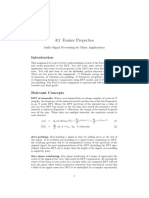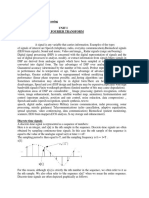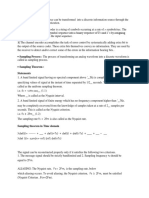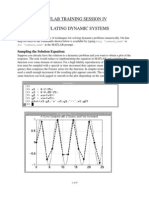Matlab Training Session Vii Basic Signal Processing: Frequency Domain Analysis
Uploaded by
Ali AhmadMatlab Training Session Vii Basic Signal Processing: Frequency Domain Analysis
Uploaded by
Ali AhmadBasic Signal Processing
MATLAB TRAINING SESSION VII BASIC SIGNAL PROCESSING
Frequency Domain Analysis:
While we will discuss both analog and digital signal processing, the focus will be on digital signal processing (DSP). Recall that an analog signal is a continuous function, usually of time, that represents information. In order to process this information with the computer, an analog signal can be sampled every T seconds, thus generating a digital signal that is a sequence of values from the original analog signal. We represent a digital signal that has been sampled from a continuous signal f(t) using the following notation: fk = f (kT). The digital signal is the sequence represented by [fk]. The time that we start collecting the samples is usually assumed to be zero, and thus the rst sample is usually referred to as f0. Hence, if a signal is sampled at 100 Hz (100 times per second), the rst three values of the digital signal correspond to the following analog signal values f0 = f(0T) = f(0.00); f1 = f(1T) = f(0.01); and f2 = f(2T) = f(0.02). To see the relationship between an analog signal and its corresponding digital signal. At the command prompt try:
1 of 8
Basic Signal Processing
Often, we will associate two vectors with a signal. One vector will signify the subscript or the sequence number and the other will represent the signal value. This will be needed so that we can use the equations from signal processing without conict with MATLABs convention for numbering the elements of a vector. Usually, a signal is analysed in two domainsthe time domain and the frequency domain. The time domain signal is represented by the data values; the frequency domain signal is represented by complex number values that represent the sinusoidal frequency components that compose the signal. Some types of information are most evident from the time domain representation of the signal. For example, by looking at the time domain plot, we can usually determine if the signal is periodic, or if it is a random signal. From the time domain values, we can also easily compute additional values such as mean, variance, and power. Other types of information, such as the frequency content of a signal, are not usually evident from the time domain, and thus we may need to compute the frequency content of the signal in order to determine if it is band-limited or if it contains certain frequencies. The frequency content of a signal is also call the frequency spectrum of the signal.
Discrete Fourier Transform:
The discrete Fourier transform (DFT) algorithm is used to convert a digital signal in the time domain into a set of points in the frequency domain. The input to the DFT algorithm is a set of N values [fk]; the algorithm then computes a set of N complex values [Fk] that represents the frequency domain information. The DFT can be very computationally intensive, however if the number of points is a power of two (N = 2M), then a special algorithm called the fast Fourier transform (FFT) can be used; the FFT greatly reduces the number of computations. Since a digital signal is sampled evert T seconds, there are 1/T samples per second; and thus the sampling rate is 1/T Hz. The selection of the sampling rate for generating a digital signal must be done carefully to avoid aliasing, a problem that is caused by sampling too slowly. To avoid aliasing, the signal must be sampled at a sampling rate that is greater than twice the frequency of the highest sinusoid content of the signal. The Nyquist frequency is equal to half the sampling rate, and represents the upper limit of the frequencies that should be contained in the digital signal.
Fast Fourier Transform:
The MATLAB function for computing the frequency content of a digital signal is the fft function. If a single input vector argument is used, the digital time domain signal, the output vector will be the same size and will contain complex values representing the frequency content of the signal. When the input vector size is a power of two, the fft algorithm is used, otherwise the DFT algorithm is used. When two input argument vectors are used, the rst vector is the time signal and the second argument is an integer (L) representing the desired number of points for the output vector. When L < N, then the rst L values are used and when L > N, then L - N zeros are appended to the input vector. The frequency domain values computed by the fft function correspond to the frequencies separated by 1/(N*T) Hz. Thus, if we have 32 samples of a time signal the was sampled at 1000 Hz, then the frequency values computed by the fft correspond to Fi = i*31.25 Hz where i = 0,1,...,31. The Nyquist frequency is equal to 1/2T (500 Hz), and thus corresponds to F16. Since
2 of 8
Basic Signal Processing
the discrete Fourier transform is a periodic function, the computed values above F16 are merely the complex conjugates of the values below, no new information is given so usually only the rst half of the output of the fft is plotted.
3 of 8
Basic Signal Processing
One more point is the concept of leakage. If there is a frequency in the time domain signal that falls in the interval between two of the discrete frequencies used in the fft, it will be detected as a component in both frequencies, but with reduced amplitude. In MATLAB an approximation of the time domain signal can be recovered using the ifft function. Try: plot(time,ifft(F))
Filter Analysis:
The transfer function of an analog system is represented by a complex function H(s), and a transfer function of a digital system is represented by a complex function H(z). These transfer functions describe the effect of the system on an input signal, termed ltering. For a given frequency 0 the lter has a magnitude K and a phase . Then, if the input to the lter contains a sinusoid with frequency 0, the output of that component will by multiplied by K and its phase will be incremented by .
A*sin(0t + )
H(s)
K*A*sin(0t + + )
The transfer function of a lter can also be described in terms of the band of frequencies that it passes. For example, a lowpass lter will pass (unalter) frequencies below a cutoff frequency and remove (attenuate) the frequencies above. There are also highpass, bandpass, and bandstop (notch) lters. In order to determine the characteristics of a transfer function, we need to plot the corresponding magnitude and phase functions. When we have a transfer function representation of the lter (i.e. a numerator polynomial and a denominator polynomial) we can look at the magnitude characteristic with the MATLAB function freqs and freqz. Try:
4 of 8
Basic Signal Processing
When determining the characteristics of a digital lter using the freqz function, 3 input arguments are required. The third argument differs from freqs in the sense that instead of specifying the frequency range, you specify the number of normalized frequency values to use over the interval [0,]. Since H(z) is applied to input signals with a sampling time of T, the appropriate range of frequencies is from 0 to the Nyquist frequency, which is /T rps or 1/(2T) Hz When we assume that z is used as a function of normalized frequency, then H(z) has a corresponding range of frequencies from 0 to . The phase of a lter can be plotted using the angle function or the unwrap function. Since the phase of a complex number is a angle in radians, the angle is only unique for a 2 interval. The output of the angle function maps the phase values to values between - and , and thus can create discontinuities at points where the phase exceeds these bounds. The unwrap function removes the 2 discontinuities introduced by the angle function when used in the reference unwrap(angle(H)). b0 + b1 z + b2 z + + bn z H ( z ) = --------------------------------------------------------------------------1 2 n a0 + a1 z + a2 z + + an z yn =
1 2 n
k = N 1
N2
bk xn k
ak yn k
k=1
N3
A digital lter can also be specied using a standard difference equation, SDE, which has the general form shown above. When N1 = 0, the coefcients [bk] and [ak] are precisely the same coefcients in the transfer function H(z). If the denominator transfer function is equal to 1, the lter is an nite impulse response lter (FIR); If the denominator transfer function is not equal to 1, the lter is an innite impulse response lter (IIR). Both types of lters are commonly used in digital signal processing.
Digital Filter Implementation:
A digital lter can be dened in terms of either a transfer function H(z) or a standard difference equation. The input to the lter is a digital signal, and the output of the lter is another digital signal. The difference equation shown above denes the steps involved in obtaining y at each discrete time n. The simplest way to apply a digital lter to a input signal in MATLAB is with the filter function. The filter function assumes that the lter is dened as the transfer function H(z). The rst two arguments to the lter function are the vector of coefcients for the numerator and denominator. The third argument is the vector representing the digital input x. The following transfer function was designed to pass frequencies between 500 and 1500 Hz
5 of 8
Basic Signal Processing
Digital Filter Design:
IIR Filter Design using Analog Prototypes: MATLAB contains functions for designing four types of digital lters based on analog lter designs. Butterworth lters have maximally at passbands and stopbands, Chebyshev Type I lters have ripple in the passband, Chebyshev Type II lters have ripple in the stopband, and elliptic lters have ripple in both bands. However, for a given lter order, elliptic lters have the sharpest transition of all these lters. The functions for designing digital lowpass IIR lters using analog prototypes have the following format: [B,A] [B,A] [B,A] [B,A] = = = = butter(N,Wn) cheby1(N,Rp,Wn) cheby2(N,Rs,Wn) ellip(N,Rp,Rs,Wn) N = lter order Rp = pass ripple Rs = stop ripple Wn = normalized cutoff frequency
To design a banpass lter, Wn should be a vector containing Wp1 and Wp2. To design a highpass lter, an additional parameter high should be added as the last function parameter. To design a bandstop lter, the additional parameter stop should be added as the last function parameter.
6 of 8
Basic Signal Processing
Direct IIR Filter Design: MATLAB has a function for performing Yule-Walker lter designs. The command is: [B,A] = yulewalk(n,f,m) The output vectors B and A contain the coefcients of the nth order IIR lter. The vectors f and m specify the frequency-magnitude characteristics of the lter over the normalized frequency range 0 to 1, which represents the Nyquist frequency range. The frequencies in f must begin with 0 and end with 1, and be increasing. The magnitudes of m must correspond to the frequencies in f, and represent the desired lter magnitude for each f.
7 of 8
Basic Signal Processing
Direct FIR Filter Design: FIR lters are designed in MATLAB using the Parks-McClellan lter design algorithm that uses the Remez exchange algorithm. Recall that FIR lters require only a B vector because the denominator polynomial of H(z) is equal to 1. The command is: B = remez(n,f,m) The arguments play the same role and have the same constrains as with the yulewalk function given above. An additional rule is that the number of points in f and m must be an even number. To obtain desirable characteristics from the FIR lter, it is not unusual for the lter order to be large.
8 of 8
You might also like
- Digital Processing of Speech Signals (Rabiner & Schafer 1978) PDF100% (2)Digital Processing of Speech Signals (Rabiner & Schafer 1978) PDF265 pages
- Lab 1. The Fourier Transform: WWW - Utdallas.edu/ kamran/EE4250No ratings yetLab 1. The Fourier Transform: WWW - Utdallas.edu/ kamran/EE425010 pages
- Brainkart_211 - IT6502 Digital Signal Processing - NotesNo ratings yetBrainkart_211 - IT6502 Digital Signal Processing - Notes112 pages
- EE1/EIE1: Introduction To Signals and Communications MATLAB ExperimentsNo ratings yetEE1/EIE1: Introduction To Signals and Communications MATLAB Experiments9 pages
- Exp#02 Analysing Biomedical Signal Using DFT and Reconstruct The Signal Using IDFTNo ratings yetExp#02 Analysing Biomedical Signal Using DFT and Reconstruct The Signal Using IDFT6 pages
- Linear Frequency Modulation Pulse Compression Technique On Generic Signal ModelNo ratings yetLinear Frequency Modulation Pulse Compression Technique On Generic Signal Model20 pages
- Laporan Simulasi: Praktikum Telekomunikasi DigitalNo ratings yetLaporan Simulasi: Praktikum Telekomunikasi Digital9 pages
- Fast Fourier Transform (FFT) : The FFT in One Dimension The FFT in Multiple DimensionsNo ratings yetFast Fourier Transform (FFT) : The FFT in One Dimension The FFT in Multiple Dimensions10 pages
- Task-01: Discrete Time Fourier TransformNo ratings yetTask-01: Discrete Time Fourier Transform5 pages
- Wireless Communication Systems Module 4: Digital Modulation and Pulse Shaping TechniquesNo ratings yetWireless Communication Systems Module 4: Digital Modulation and Pulse Shaping Techniques9 pages
- Summer Internship Presentation On "Channel and RF Impairment Modeling For MIMO"No ratings yetSummer Internship Presentation On "Channel and RF Impairment Modeling For MIMO"22 pages
- Using MATLAB To Plot The Fourier Transform of A Time FunctionNo ratings yetUsing MATLAB To Plot The Fourier Transform of A Time Function13 pages
- VI Lect - Notes#3 Btech Vii Sem Aug Dec2022No ratings yetVI Lect - Notes#3 Btech Vii Sem Aug Dec2022164 pages
- A4: Short-Time Fourier Transform (STFT) : Audio Signal Processing For Music ApplicationsNo ratings yetA4: Short-Time Fourier Transform (STFT) : Audio Signal Processing For Music Applications6 pages
- Digital Communications Assignment: By: Francisco Cantero - 12040673No ratings yetDigital Communications Assignment: By: Francisco Cantero - 1204067325 pages
- Time and Frequency Analysis of Discrete-Time SignalsNo ratings yetTime and Frequency Analysis of Discrete-Time Signals15 pages
- Sampling Process: The Process of Transforming An Analog Waveform Into A Discrete Waveform IsNo ratings yetSampling Process: The Process of Transforming An Analog Waveform Into A Discrete Waveform Is7 pages
- Digital Filter Design For Audio Processing: Ethan Elenberg Anthony Hsu Marc L'HeureuxNo ratings yetDigital Filter Design For Audio Processing: Ethan Elenberg Anthony Hsu Marc L'Heureux31 pages
- Some Case Studies on Signal, Audio and Image Processing Using MatlabFrom EverandSome Case Studies on Signal, Audio and Image Processing Using MatlabNo ratings yet
- Fundamentals of Electronics 3: Discrete-time Signals and Systems, and Quantized Level SystemsFrom EverandFundamentals of Electronics 3: Discrete-time Signals and Systems, and Quantized Level SystemsNo ratings yet
- Adaptive Filter: Enhancing Computer Vision Through Adaptive FilteringFrom EverandAdaptive Filter: Enhancing Computer Vision Through Adaptive FilteringNo ratings yet
- Matlab Training Session Iv Simulating Dynamic Systems: Sampling The Solution EquationNo ratings yetMatlab Training Session Iv Simulating Dynamic Systems: Sampling The Solution Equation9 pages
- Electrical Theory: Howard W Penrose, PH.D., CMRP InstructorNo ratings yetElectrical Theory: Howard W Penrose, PH.D., CMRP Instructor79 pages
- The Purpose of Business Activity: LECTURE # 01 & 02No ratings yetThe Purpose of Business Activity: LECTURE # 01 & 029 pages
- Introduction To: Artificial IntelligenceNo ratings yetIntroduction To: Artificial Intelligence31 pages
- The Purpose of Business Activity: LECTURE # 01 & 02No ratings yetThe Purpose of Business Activity: LECTURE # 01 & 029 pages
- Matlab Training Session Iii Numerical Methods: Solutions To Systems of Linear EquationsNo ratings yetMatlab Training Session Iii Numerical Methods: Solutions To Systems of Linear Equations14 pages
- Matlab Training Session Ii Data Presentation: 2-D PlotsNo ratings yetMatlab Training Session Ii Data Presentation: 2-D Plots8 pages
- Introduction To VHDL: AIR University AU, E-9, IslamabadNo ratings yetIntroduction To VHDL: AIR University AU, E-9, Islamabad29 pages
- 2-Level Logic ( 0', 1') .: Introduction To ASIC DesignNo ratings yet2-Level Logic ( 0', 1') .: Introduction To ASIC Design8 pages
- System On Chips Soc'S & Multiprocessor System On Chips MpsocsNo ratings yetSystem On Chips Soc'S & Multiprocessor System On Chips Mpsocs42 pages
- Example 5.1: Multiplexer #1 Using OperatorsNo ratings yetExample 5.1: Multiplexer #1 Using Operators10 pages
- Introduction To ASIC Design: Lab Report InstructionsNo ratings yetIntroduction To ASIC Design: Lab Report Instructions1 page
- Introduction To Symbian Os: AIR University AU, PAF Complex, E-9, IslamabadNo ratings yetIntroduction To Symbian Os: AIR University AU, PAF Complex, E-9, Islamabad64 pages
- Introduction To ASIC Design: Lab Report StandardsNo ratings yetIntroduction To ASIC Design: Lab Report Standards1 page
- Air University Fall 2005 Faculty of Engineering Department of Electronics Engineering Course InformationNo ratings yetAir University Fall 2005 Faculty of Engineering Department of Electronics Engineering Course Information2 pages
- High Efficiency Video Coding With Content Split Block Search Algorithm and Hybrid Wavelet TransformNo ratings yetHigh Efficiency Video Coding With Content Split Block Search Algorithm and Hybrid Wavelet Transform7 pages
- A Fully Progressive Approach To Single Image Super Resolution Paper 1No ratings yetA Fully Progressive Approach To Single Image Super Resolution Paper 110 pages
- Swarna Bharathi Institute of Science and TechnologyNo ratings yetSwarna Bharathi Institute of Science and Technology18 pages
- Digital Signal Prosessing Laboratory EEEB 363No ratings yetDigital Signal Prosessing Laboratory EEEB 36311 pages
- Create Your Own CamScanner Using Python and OpenCVNo ratings yetCreate Your Own CamScanner Using Python and OpenCV20 pages
- Procesamiento Digital de Señales: Jhon James Granada TorresNo ratings yetProcesamiento Digital de Señales: Jhon James Granada Torres39 pages
- Digital Watermarking: First A. Author, Second B. Author, JR., and Third C. Author, Member, IEEENo ratings yetDigital Watermarking: First A. Author, Second B. Author, JR., and Third C. Author, Member, IEEE2 pages
- Q1) The Following Figure Shows A 3-Bit Image of Size 5-By-5 Image in The SquareNo ratings yetQ1) The Following Figure Shows A 3-Bit Image of Size 5-By-5 Image in The Square3 pages
- Digital Processing of Speech Signals (Rabiner & Schafer 1978) PDFDigital Processing of Speech Signals (Rabiner & Schafer 1978) PDF
- Lab 1. The Fourier Transform: WWW - Utdallas.edu/ kamran/EE4250Lab 1. The Fourier Transform: WWW - Utdallas.edu/ kamran/EE4250
- Brainkart_211 - IT6502 Digital Signal Processing - NotesBrainkart_211 - IT6502 Digital Signal Processing - Notes
- EE1/EIE1: Introduction To Signals and Communications MATLAB ExperimentsEE1/EIE1: Introduction To Signals and Communications MATLAB Experiments
- Exp#02 Analysing Biomedical Signal Using DFT and Reconstruct The Signal Using IDFTExp#02 Analysing Biomedical Signal Using DFT and Reconstruct The Signal Using IDFT
- Linear Frequency Modulation Pulse Compression Technique On Generic Signal ModelLinear Frequency Modulation Pulse Compression Technique On Generic Signal Model
- Laporan Simulasi: Praktikum Telekomunikasi DigitalLaporan Simulasi: Praktikum Telekomunikasi Digital
- Fast Fourier Transform (FFT) : The FFT in One Dimension The FFT in Multiple DimensionsFast Fourier Transform (FFT) : The FFT in One Dimension The FFT in Multiple Dimensions
- Wireless Communication Systems Module 4: Digital Modulation and Pulse Shaping TechniquesWireless Communication Systems Module 4: Digital Modulation and Pulse Shaping Techniques
- Summer Internship Presentation On "Channel and RF Impairment Modeling For MIMO"Summer Internship Presentation On "Channel and RF Impairment Modeling For MIMO"
- Using MATLAB To Plot The Fourier Transform of A Time FunctionUsing MATLAB To Plot The Fourier Transform of A Time Function
- A4: Short-Time Fourier Transform (STFT) : Audio Signal Processing For Music ApplicationsA4: Short-Time Fourier Transform (STFT) : Audio Signal Processing For Music Applications
- Digital Communications Assignment: By: Francisco Cantero - 12040673Digital Communications Assignment: By: Francisco Cantero - 12040673
- Time and Frequency Analysis of Discrete-Time SignalsTime and Frequency Analysis of Discrete-Time Signals
- Sampling Process: The Process of Transforming An Analog Waveform Into A Discrete Waveform IsSampling Process: The Process of Transforming An Analog Waveform Into A Discrete Waveform Is
- Digital Filter Design For Audio Processing: Ethan Elenberg Anthony Hsu Marc L'HeureuxDigital Filter Design For Audio Processing: Ethan Elenberg Anthony Hsu Marc L'Heureux
- Some Case Studies on Signal, Audio and Image Processing Using MatlabFrom EverandSome Case Studies on Signal, Audio and Image Processing Using Matlab
- Fundamentals of Electronics 3: Discrete-time Signals and Systems, and Quantized Level SystemsFrom EverandFundamentals of Electronics 3: Discrete-time Signals and Systems, and Quantized Level Systems
- Adaptive Filter: Enhancing Computer Vision Through Adaptive FilteringFrom EverandAdaptive Filter: Enhancing Computer Vision Through Adaptive Filtering
- Matlab Training Session Iv Simulating Dynamic Systems: Sampling The Solution EquationMatlab Training Session Iv Simulating Dynamic Systems: Sampling The Solution Equation
- Electrical Theory: Howard W Penrose, PH.D., CMRP InstructorElectrical Theory: Howard W Penrose, PH.D., CMRP Instructor
- The Purpose of Business Activity: LECTURE # 01 & 02The Purpose of Business Activity: LECTURE # 01 & 02
- The Purpose of Business Activity: LECTURE # 01 & 02The Purpose of Business Activity: LECTURE # 01 & 02
- Matlab Training Session Iii Numerical Methods: Solutions To Systems of Linear EquationsMatlab Training Session Iii Numerical Methods: Solutions To Systems of Linear Equations
- Matlab Training Session Ii Data Presentation: 2-D PlotsMatlab Training Session Ii Data Presentation: 2-D Plots
- Introduction To VHDL: AIR University AU, E-9, IslamabadIntroduction To VHDL: AIR University AU, E-9, Islamabad
- 2-Level Logic ( 0', 1') .: Introduction To ASIC Design2-Level Logic ( 0', 1') .: Introduction To ASIC Design
- System On Chips Soc'S & Multiprocessor System On Chips MpsocsSystem On Chips Soc'S & Multiprocessor System On Chips Mpsocs
- Introduction To ASIC Design: Lab Report InstructionsIntroduction To ASIC Design: Lab Report Instructions
- Introduction To Symbian Os: AIR University AU, PAF Complex, E-9, IslamabadIntroduction To Symbian Os: AIR University AU, PAF Complex, E-9, Islamabad
- Air University Fall 2005 Faculty of Engineering Department of Electronics Engineering Course InformationAir University Fall 2005 Faculty of Engineering Department of Electronics Engineering Course Information
- High Efficiency Video Coding With Content Split Block Search Algorithm and Hybrid Wavelet TransformHigh Efficiency Video Coding With Content Split Block Search Algorithm and Hybrid Wavelet Transform
- A Fully Progressive Approach To Single Image Super Resolution Paper 1A Fully Progressive Approach To Single Image Super Resolution Paper 1
- Swarna Bharathi Institute of Science and TechnologySwarna Bharathi Institute of Science and Technology
- Create Your Own CamScanner Using Python and OpenCVCreate Your Own CamScanner Using Python and OpenCV
- Procesamiento Digital de Señales: Jhon James Granada TorresProcesamiento Digital de Señales: Jhon James Granada Torres
- Digital Watermarking: First A. Author, Second B. Author, JR., and Third C. Author, Member, IEEEDigital Watermarking: First A. Author, Second B. Author, JR., and Third C. Author, Member, IEEE
- Q1) The Following Figure Shows A 3-Bit Image of Size 5-By-5 Image in The SquareQ1) The Following Figure Shows A 3-Bit Image of Size 5-By-5 Image in The Square





















































































































